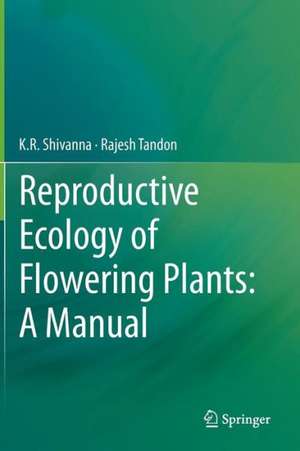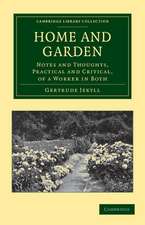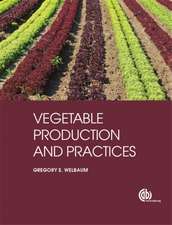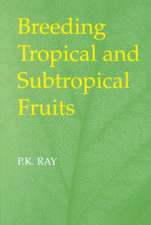Reproductive Ecology of Flowering Plants: A Manual
Autor K. R. Shivanna, Rajesh Tandonen Limba Engleză Hardback – 16 sep 2014
The Manual fills this void. Over 60 protocols described in the manual cover the whole spectrum of reproductive ecology - study sites and species, phenology, floral morphology and sexuality, pollen and pistil biology, pollination ecology, breeding system, seed biology, seed dispersal and seedling recruitment. Each chapter gives a concise conceptual account of the topic before describing the protocols. The Manual caters to researchers, teachers and students who are interested in any aspect of reproductive ecology of flowering plants -- botanists, ecologists, agri-horticulturists, foresters, entomologists, plant breeders and conservation biologists.
| Toate formatele și edițiile | Preț | Express |
|---|---|---|
| Paperback (1) | 637.46 lei 6-8 săpt. | |
| Springer India – 10 sep 2016 | 637.46 lei 6-8 săpt. | |
| Hardback (1) | 644.95 lei 6-8 săpt. | |
| Springer India – 16 sep 2014 | 644.95 lei 6-8 săpt. |
Preț: 644.95 lei
Preț vechi: 758.77 lei
-15% Nou
Puncte Express: 967
Preț estimativ în valută:
123.44€ • 127.21$ • 104.22£
123.44€ • 127.21$ • 104.22£
Carte tipărită la comandă
Livrare economică 03-17 martie
Preluare comenzi: 021 569.72.76
Specificații
ISBN-13: 9788132220022
ISBN-10: 8132220021
Pagini: 180
Ilustrații: XV, 170 p. 23 illus., 18 illus. in color.
Dimensiuni: 178 x 254 x 17 mm
Greutate: 0.54 kg
Ediția:2014
Editura: Springer India
Colecția Springer
Locul publicării:New Delhi, India
ISBN-10: 8132220021
Pagini: 180
Ilustrații: XV, 170 p. 23 illus., 18 illus. in color.
Dimensiuni: 178 x 254 x 17 mm
Greutate: 0.54 kg
Ediția:2014
Editura: Springer India
Colecția Springer
Locul publicării:New Delhi, India
Public țintă
ResearchCuprins
1. Introduction.- 2. Study Plants and Sites.- 3. Phenology.- 4. Floral Morphology and Sexuality.- 5. Pollen Biology.- 6. Pistil Biology.- 7. Pollination Ecology.- 8. Pollen-Pistil Interaction.- 9. Breeding Systems.- 10. Fruit and Seed Biology.- 11. Seed Dispersal.- 12. Seedling Recruitment.- 13. Appendices.
Notă biografică
K.R. Shivanna, formerly Professor and Head, Department of Botany, University of Delhi is now associated with Ashoka Trust for Research in Ecology and the Environment, Bangalore as INSA Honorary Scientist and Honorary Senior Fellow. He has been doing research on reproductive biology of flowering plants for over 50 years. He has published over 150 original research papers in refereed journals and authored/edited five books on pollen biology and biotechnology. He has worked at the Royal Botanic Gardens, Kew, UK, Welsh Plant Breeding Station, Wales, UK, University of Melbourne, Australia, University of Siena, Italy and University of Saskatchewan, Saskatoon, Canada as a Visiting Scientist/Professor. He is a recipient of many awards including Panchanan Maheshwari Medal, and a Fellow of the Indian National Science Academy, Indian Academy of Sciences, National Academy of Agricultural Sciences and National Academy of Sciences, India. Rajesh Tandon is currently working as Associate Professor at Department of Botany in University of Delhi. He did his Ph.D. in 1998 from the University of Delhi. Since then he has been teaching and conducting research at the Department of Botany, University of Delhi, and his research interests have been plant reproduction, developmental biology and conservation biology. He has published over 30 research papers in reputed international journals and contributed chapters to several books. He is a recipient of Dr Y.S. Murthy Young Scientist Award by the Indian Botanical Society.
Textul de pe ultima copertă
Successful reproduction is the basis not only for the stability of the species in their natural habitat but also for productivity of our crop plants. Therefore, knowledge on reproductive ecology of wild and cultivated plants is important for effective management of our dwindling biodiversity and for the sustainability and improvement of the yield in crop species. Conservation and management of our plant diversity is going to be a major challenge in the coming decades, particularly in the tropical countries which are rich in biodiversity. Reproductive failure is the main driver for pushing a large number of tropical species to vulnerable category. Available data on reproductive ecology on tropical species is very limited and there is an urgent need to initiate research on these lines. A major limitation for the beginners to take up research is the absence of simple concise work manuals that provide step-wise procedures to study all aspects of reproductive ecology.
The Manual fills this void. Over 60 protocols described in the Manual cover the whole spectrum of reproductive ecology - study sites and species, phenology, floral morphology and sexuality, pollen and pistil biology, pollination ecology, breeding system, seed biology, seed dispersal and seedling recruitment. Each chapter gives a concise conceptual account of the topic before describing the protocols. The Manual caters to researchers, teachers and students who are interested in any aspect of reproductive ecology of flowering plants -- botanists, ecologists, agri-horticulturists, foresters, entomologists, plant breeders and conservation biologists.
The Manual fills this void. Over 60 protocols described in the Manual cover the whole spectrum of reproductive ecology - study sites and species, phenology, floral morphology and sexuality, pollen and pistil biology, pollination ecology, breeding system, seed biology, seed dispersal and seedling recruitment. Each chapter gives a concise conceptual account of the topic before describing the protocols. The Manual caters to researchers, teachers and students who are interested in any aspect of reproductive ecology of flowering plants -- botanists, ecologists, agri-horticulturists, foresters, entomologists, plant breeders and conservation biologists.
Caracteristici
Covers the whole spectrum of reproductive ecology in 13 chapters from study sites and plants until seedling survival Explicitly gives enough conceptual background on the topic before describing the protocols Includes over 60 protocols and each gives a brief introduction followed by special requirements needed and step-by-step description of procedures so that the researchers do not find any difficulty in planning and executing the work







